They do say silence is golden but it has been several months since we last updated the website with news of what we have been up to. So for those following the venture thank you for bearing with us whilst we were quiet on here for reasons that will hopefully become clear within this update and we promise to make far more regular news posts from now on. So when you have a few minutes spare and are interested, put your reading glasses on, put your feet up and digest the following.
So why has the website been quiet for a few months? Well in the first instance after our previous update we made a number of enquires for financial sponsorship. One such enquiry resulted in us entering into dialogue with a wealthy company who rather put us in a spin with their request that if money was no object, could we construct the entire craft, complete with a fast jet engine capable of mounting a serious challenge upon the Outright World Water Speed Record within the year. Those that have been following our venture will appreciate that our initial intention was to build a jet hydroplane with a Viper gas turbine as a learning platform, before considering whether to go on to mount a serious attempt upon this record.
In order to accommodate such a credible enquiry we had to provide realistic costings. The request of a very short timeframe for completion of the craft meant we would be looking at a composite hull rather than traditional timber as originally intended but one of our product partners stated they would be prepared to form such a hull for an appropriate fee. Fast jet engine choice was, with an open cheque book, quite broad with engines from all over the world able to be considered and these were incorporated into the response to the enquirer. That proposal was welcomed by the enquirer themselves who responded ‘that the venture seemed like fun’.
So why are we not nearing completion of a composite hull craft on a money no object basis? Because after going through several departments of the enquirer’s worldwide business for approval, the shadow of Donald Campbell’s fatal crash in Bluebird in the Lake District back in 1967 appears to be still very much in some sponsor’s mind when it comes to this water speed record. This is great for keeping the legend of the Campbell’s and their Bluebirds alive but not so good for trying to raise financial sponsorship for a new jet hydroplane.
When the enquirer was reminded of the potential adverse publicity to their company should a similar accident happen the question was asked ‘can we guarantee that no such accident would occur?’. The answer even to a layperson was no it would be reckless of us to suggest that the water speed record attempt is not inherently hazardous and despite assurances that those hazards would be managed to reduce the risks as best we might, that was not enough and that particular enquiry folded.
Although on the one hand this was disappointing and had cost us a good deal of time and effort to provide realistic costings, a credible design etc, this did have its positives in that it spurred us on to design and build a craft from the outset able to challenge the record, rather than our initial thoughts of constructing a smaller, less powerful craft, simply as a learning platform.
With regards to sponsorship there appear to be two types of reactions with regards to backing an attempt upon the water speed record. With some as illustrated above, the glass is half empty, wanting not to be associated with the risk of any adverse publicity with even say a partial sinking of the craft as happened when Helical Technology ran their K777 Bluebird replica. Whilst others thankfully are excited by the prospect of seeing a pure thrust jet hydroplane run at speed in the UK once again and attempt to challenge this record with them considering it a unique patriotic high energy attraction.
Whilst much has been made of the water speed record being the most dangerous sport in the world, we would argue strongly against that simply on a statistical basis. That is to say since setting the current record back in 1978, there have only been two fatalities in almost 40 years, compared to say the annual TT motorcycle races on the Isle of Man which killed 132 riders within the same period but sponsors are queuing up to back the TT year on year.
Nobody is making DJ get into the cockpit of Longbow. He will be in there because he wants to be and as a military pilot and hydroplane racer, he has the training to manage the environment he places himself in with a methodical risk averse approach to running the craft as safely as he might.
Engines
Before moving on to gas turbines some may ask have we not considered rockets as a power-plant for Longbow and the answer is yes we have. Some time ago we discussed their use with rocket engineer Daniel Jubb who was very much involved with the rocket for the Bloodhound land speed car and more recently we discussed them again with David Knight along with other experts in this field abroad. There are both advantages and disadvantages with such engines for our application. One advantage is that you do not need to worry about positioning of air intakes in relation to the driver as a rocket does not require air intakes. Another advantage is for example High Test Peroxide (HTP) rocket fuel decomposes to environmentally friendly steam and oxygen.
Downsides to rockets are that in some cases the fuel is not cheap and again for example with HTP considerable care is required in handling and storing the fuels. When we are wanting to run the craft many times as a learning platform using an expensive fuel is not helpful on a limited budget and this is even mirrored with the Bloodhound land speed car undertaking their initial tests without the use of their rocket engine. Steam rockets are a possibility but then there are issues of refuelling for the return run within the hour that is required for this particular record. Another disadvantage with many rockets is the burn time of the rocket fuel is very rapid and hence with it so is a shift in the centre of mass for such a craft which could cause instability if not carefully catered for.
For the speed range we are seeking to run the craft, the timeframe for refuelling issue and the fact that we required an engine that was reliable and relatively cheap to run many times, we therefore come back to the trusty gas turbine. For this we had our gas turbine engineers making enquires for a number of engines both within the UK and abroad.
We had been told by the Minister for the DSA that the Eurofighter EJ200 engines used for Bloodhound were a one off not to be repeated and that any engines that were released for disposal by the DSA we would have to purchase at open market value so the taxpayer had the best return, although we would be offered first chance of refusal.
The existing record was gained using an American Westinghouse J34 gas turbine with an output of 3400 lbs static thrust weighing approximately 1250 lbs no longer in production. A brilliant robust narrow diameter engine, side mounted with its own electric start. With regards to performance figures we are actually more interested in the mass flow rate of the engine per second which is the amount of air passing through the engine but as a general comparison static thrust is used herein as a comparison.
Dave Warby had managed to get hold of an Orpheus engine in Italy (plus one spare for the successor to the record winning craft and this option of using a more powerful engine without afterburner (reheat) was preferred to adding reheat to the J34, as the manner of doing so was found to upset the stability of the craft when the afterburner was both lit and extinguished.
Engines we considered for the craft were the following (thrust range shown reflects different models or engine in dry and then re-heat mode):
Engine: Orpheus (dry)
Thrust: 4500 – 5000
Weight (approx): 1100
Aircraft platform: Folland Gnat / Fiat G91
Engine: Adour (dry)
Thrust: 5200 – 6200
Weight (approx): 1300
Aircraft platform: Hawk
Engine: Adour (reheat)
Thrust: 5200 – 7300
Weight (approx): 1700
Aircraft platform: Jaguar
Engine: Spey (dry)
Thrust: 11900
Weight (approx): 2700
Aircraft platform: Nimrod
Engine: Tumansky R11 (reheat)
Thrust: 8650 – 11900
Weight (approx): 2400
Aircraft platform: MIG
Engine: Viper 535 (dry)
Thrust: 3400
Weight (approx): 750
Aircraft platform: Strikemaster
Engine: RB199(reheat)
Thrust: 8800 – 16000
Weight (approx): 2100
Aircraft platform: Tornado
We would require at least two engines (one for spare), plus jet pipe where applicable and a means of starting the engine at either end of the lake. It would also be helpful to have log books, some additional spares, manuals and although we were in effect ground running these engines, for insurance purposes, it would be helpful to have remaining flight time left upon the engine.
Having made several enquires abroad it transpired that sourcing two Tumansky R11 engines, or its slightly heavier successor the R13, in good condition with paperwork and hours remaining was just too difficult to source at time of our enquiries.
Some would also argue that for a British attempt upon the record using a Soviet engine was not in the spirit of things but having said that, Rolls Royce aero engine division is multinational these days and despite them assisting with the Bloodhound land speed car, the Bluebird cars and boats, they flatly refused to have anything to do with supporting or endorsing their engines for a current British water speed record attempt.
Feedback from the DSA and their nominated contractors suggested that there was little hope of a pair of dry Adours or RB199’s in serviceable condition being released any time soon. The Adours from the Hawk going back to RR for overhaul as were the RB199’s from the Tornado at time of enquiry.
Also it had to be appreciated that in the case of the RB199 it is, when compared to some of the other engines upon the above list, a highly complex engine being electronically driven that would not be the easiest to manage at the lakeside (water and electronics never being a good combination). It is also top hung with all of its thrust going through one upper support pin. Furthermore being a re-heated engine, there is no additional jet pipe at the rear of this engine such that all of the engine weight would by layout be positioned towards the rear of the craft. From a stability point of view this is undesirable (think trying to throw a dart backwards). Whilst this could be countered by adding weight forward to achieve the required trim this could lead to a condition of diminishing returns given the amount of correcting ballast would be considerable.
The Spey from the Nimrod is readily available to purchase from several civilian contractors and is far less complicated to run than the RB199. Some of the difficulties we would face using this engine are that there is a limited availability of jet pipes although we believe two are in the Buccaneer parked outside a garage in Scotland and comparative to some engines the Spey’s weight and diameter (it is a bypass engine) are both considerable. That would in turn require a craft in excess of 40 feet long in order to satisfy the buoyancy requirement, which in turn was well beyond our current workshop length. Not a problem if we had a wealthy financial backer but on a limited budget, funding alternative premises and it being less convenient to work on part time would for us be a significant issue.
In addition the engine does not counter rotate, so there is the issue of a significant amount of rotating mass upon acceleration and deceleration. Ron Ayres suggested the water surface at speed would be sufficiently hard enough to discount the issue but our good friend Dave Warby, based upon not only his experience with SOAII but also with jet cars and trucks using engines with considerable rotating mass, suggested if possible it was something best avoided in a delicately balanced jet hydroplane. We also looked at the aged Avon but again this was discounted for the same reason.
The Orpheus is a lovely relatively simple light powerful engine but as it is no longer in production, is becoming increasingly hard to source in good condition and those that do have engines / spares are tending to hold on to them.
Earlier in the year we were contacted by a DSA nominated contractor to inform us that several re-heated Adours were being released by the MOD and we could have first refusal to purchase them if we would like to come and view them which we duly did. The reheated Adour is a relatively short engine so again with no jet pipe all of that weight would be towards the rear of the craft which as previously stated would be undesirable for stability. It is also another top hung engine so again an additional headache and it requires an air producer (often a smaller gas turbine) to start it. We could however consider inserting a length of jet pipe between the main engine and its reheat module in order to bring the position of the engine forward within the hull but that would not be easy given all of the fuel system etc that would need to be lengthened.
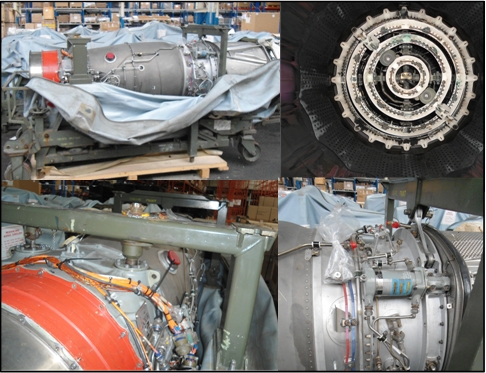
These particular engines were former training school units and had been stripped and rebuilt during tuition in addition to having either stage 1 modules missing or damaged intentionally so the students could practice blending of the damaged forward compressor blades. In addition they were stamped ‘scrap’ upon the engine casings and were without log books.
Nevertheless we did make an offer to purchase the engines for overhaul based upon their scrap value from such previous sales, as we are fortunate enough to have gas turbine engineers who are trained upon them assisting with the venture who felt confident that with work and their existing spares they could be made to run for our application.
However we were then informed that an Indian buyer with deep pockets had offered £20-30K per engine depending upon unit model and as we were not in a position to outbid them they were duly sold. Furthermore we were informed that any further Adours being released by the DSA would be snatched up by the same buyer at whatever price was needed to secure them.
To be fair this was not really surprising since the Adour is still in use by a number of aircraft including within the Indian flown Jaguars. We even knew of a couple of reheated Adours that the owner would not sell as complete engines as they were actually more valuable to be broken down for resale as individual parts.
Setting out our requirements we needed a power-plant that was preferably readily available in the UK, that had flight hours remaining and log books, one that had readily available spares, was relatively small in diameter, ideally had factory made electric start for ease of onboard starting at either end of the lake, an engine that was not out of preference afterburning / reheated so that the engine could be brought well forward in the hull to aid stability with a long jet pipe and which was side mounted. As we pondered this through looking at the Viper 535 we already had in the workshop which matched all of those requirements other than it was only equal in thrust to the Westinghouse J34 that had captured the record, it wasn’t too much of a light bulb moment to come up with the idea of using two Vipers sat side by side.
The disadvantages associated with using two engines is not surprisingly there is two of everything to potentially have a problem with, although gas turbines with flight hours remaining as a general rule are very reliable. Additionally if the engines were set some way apart and we had an engine failure during running the craft, then there is potential for an unrecoverable instability to occur, so our requirement is to have the engines as close together and as far forward within the hull as we can accommodate them.
When running a large thrust single engine, if that engine were to suddenly fail during a run the resultant intake drag combined with unloading the bow could result in an unrecoverable pitch up moment. With two smaller engines fitted side by side to give the same total thrust, if one were to fail then comparatively only half the thrust is lost and only half the intake drag occurs such that there may be scope for managing the situation to recovery as an alternative to shutting both engines down.
As regards to accommodating the fuel load with a single engine we would have tried to arrange the tanks being supplied by Advanced Fuel Systems to be at around the centre of mass for the craft so that fuel consumption during a run did not adversely effect the trim of Longbow. However with two engines side by side occupying the volume within the hull at this point the logical place to locate the fuel tanks is beneath the jet pipes such that as fuel is consumed and speed increases, the centre of mass shifts desirably forward.
With twin engines a central engine bearer is required along with two outer ones that would normally be associated with a single engine layout but another advantage of the twin engine layout is that the central engine bearer should also provide an excellent fixture for the rudder and tail-plane mountings.
When all of the above was considered we became more and more excited about this layout and when I mentioned this to Dave Warby, we were surprised to learn that had they not been lucky enough to source their rare Orpheus engine, then twin Vipers side by side is what they would have opted for within their latest jet hydroplane SOAII even to the point of doing a layout concept of such an arrangement. With such an endorsement the decision to run with twin Vipers was easily made and additional engines, jet pipes and starters etc were then purchased.
Once we had decided upon engine choice, new layout drawings were again required for the twin Viper layout, all of which take time to produce. In the meantime Dr. Ben Evans, who along with his students at Swansea University had done some incredible CFD work on Bloodhound offered to take a look at our craft. This was very kind of Dr. Evans and the students given the research was unfunded and they were giving freely of their time and effort to assist.
As a starting point for their analysis Paul Bulman, MD of Manchester Metrology generously offered to scan the buck we had made for the driver capsule with their Faro equipment, given its complex shape. The following photographs show it being scanned by Neil Blakeman of Manchester Metrology at the premises of Aximo design engineers with Kevin Hardcastle of Aximo and his staff kindly supporting the venture. Following their onsite visit to Aximo, Neil formed a NURBS model of the cockpit buck and sent this to Dr. Ben Evans who is working upon it with one of his students Jack Townsend.
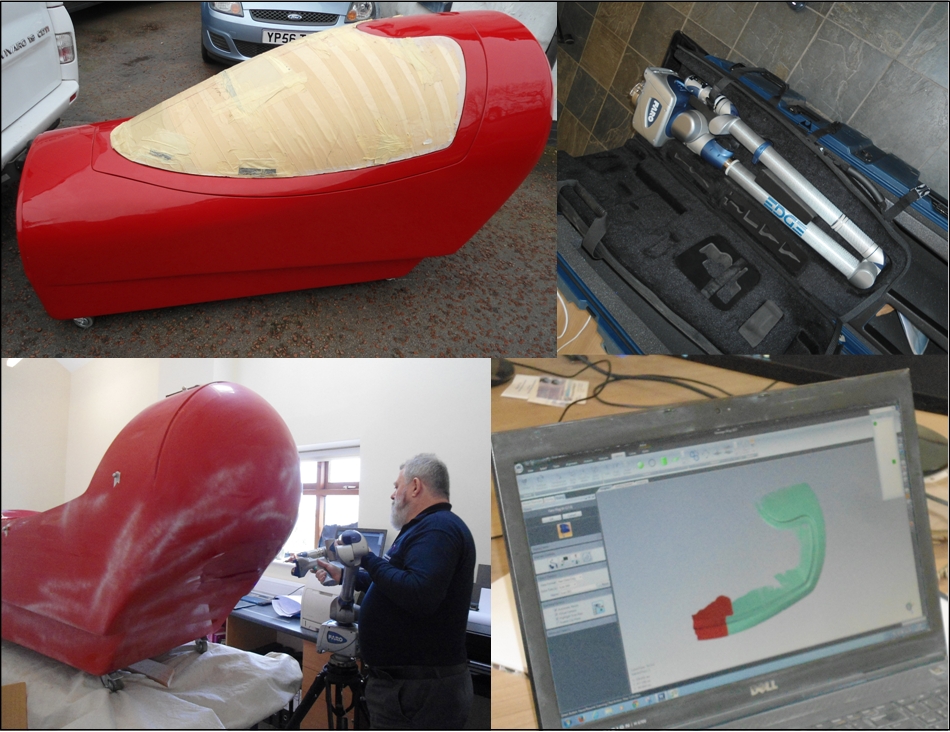
We are also pleased to announce Norson maritime design engineers, Andrew Lea and George Robson have come on board with the venture and are working with Swansea University to assist us.
Once we knew where we were with things we could then form the steel grillage to fabricate the engine bearers and then build Longbow up from within our workshop using the steelwork and fittings provided by our sponsors West Yorkshire Steel, Kee Safety and Avon Stainless Fasteners.
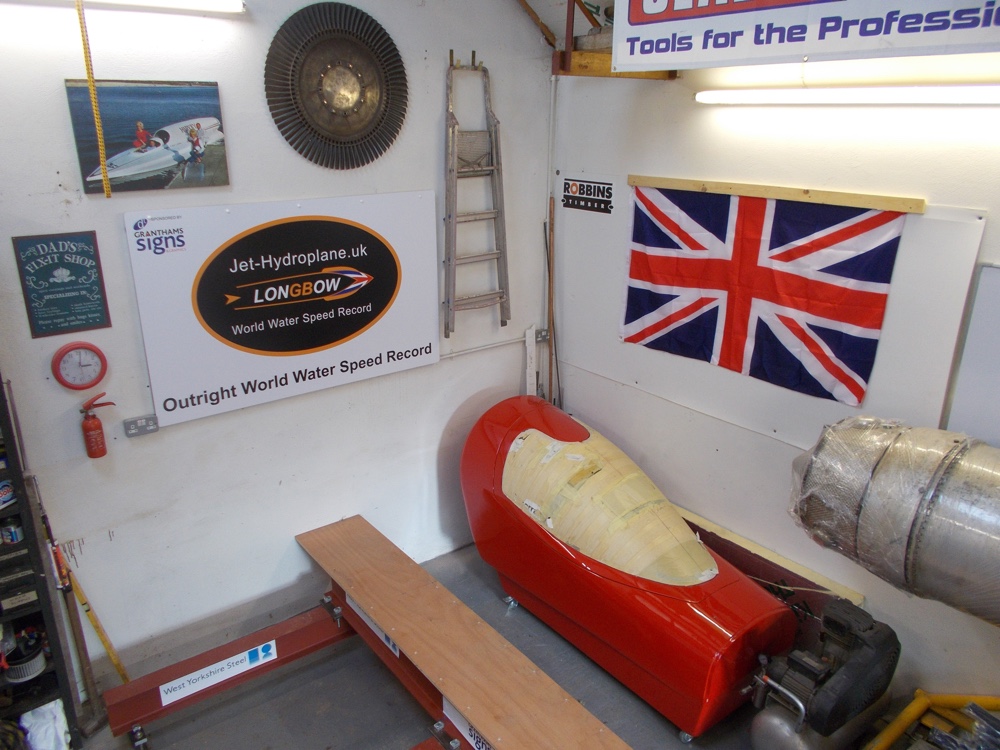
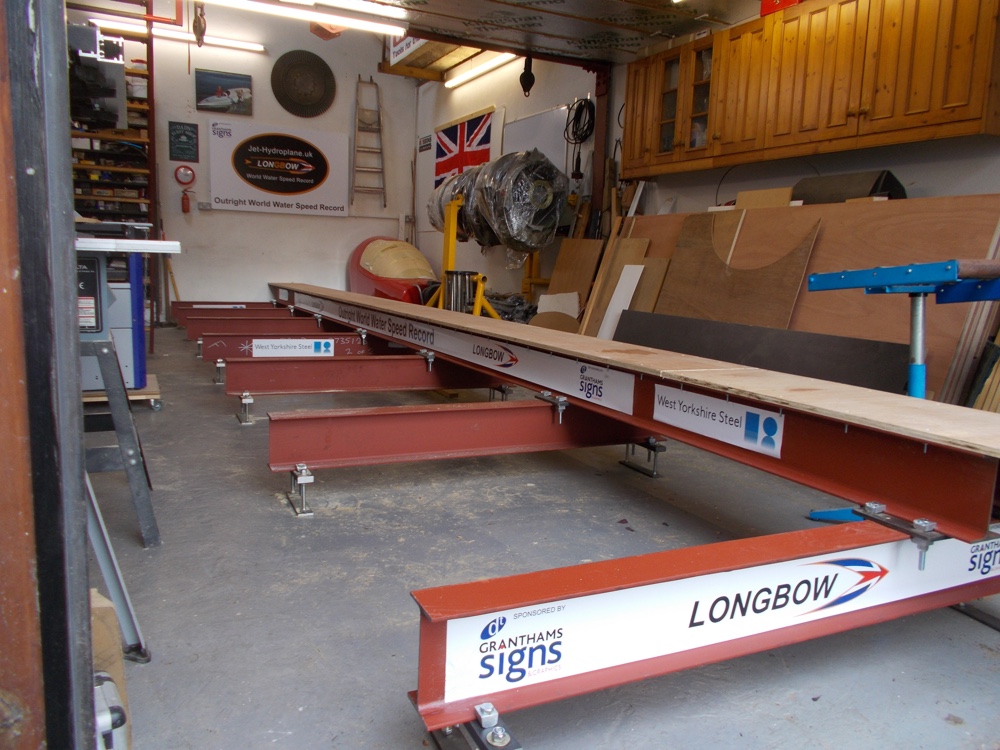
We then went back to our specialist timber sponsor Robbins, to order the Sitka Spruce for the engine bearers but unfortunately availability to Europe in the lengths and sizes that we need is considerably curtailed at the moment by North American clears, such that it will be the end of December before they have the necessary shipment of the specific timber sizes we require. Sealey have kindly supplied clamps for forming the engine bearers and have offered to supply workshop heaters as necessary to keep us and the epoxy from Wessex / West System from freezing as winter approaches.
Whilst we have been patiently proceeding with all of the above David-John (DJ) has been continuing racing his hydroplane this season, undertaking his annual dunk test cockpit training and continuing his day to day job as a pilot in the Royal Navy and DJ will be doing an update of that shortly. For my part I managed to restore and landscape the rear garden after removing all the Leylandii left it looking like a battlefield scene.
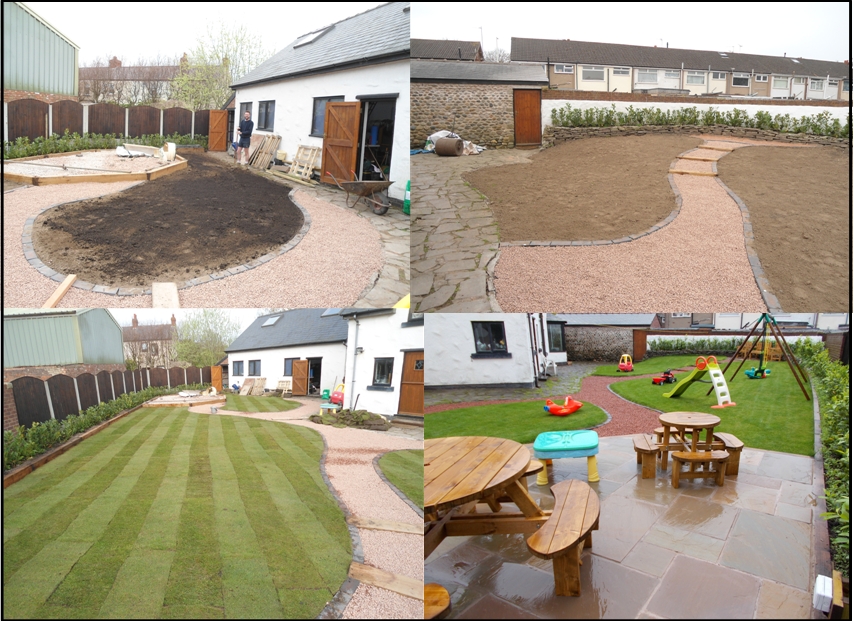
I am also now a proud grandfather as my eldest daughter Hannah gave birth to little Eleanor in late July so as she grows hopefully the venture will too.

Steve our wood and engineering guru has been building an extension along with major house refurbishment. This has been after his daytime work and at weekends, with his girlfriend pushing him to get it completed for Christmas, so it is perhaps just as well we are currently waiting upon material arriving from North America!
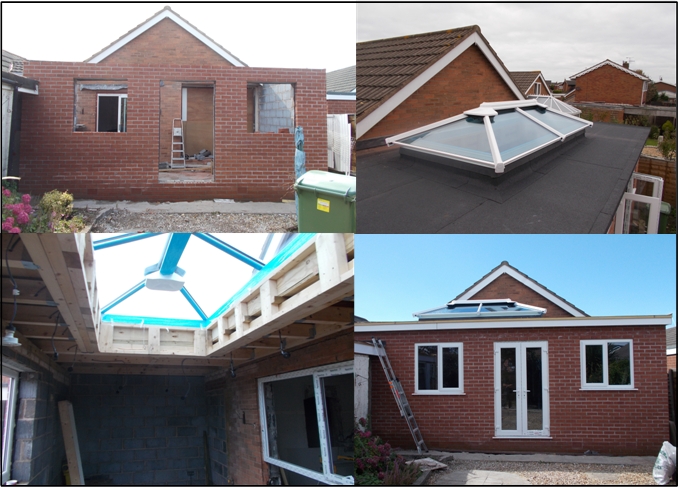
Thanks also to another of our sponsors Granthams for assisting with the supply of team clothing and signage to the project which makes us look a bit more presentable when building the craft, at meetings and for when it comes to running Longbow.
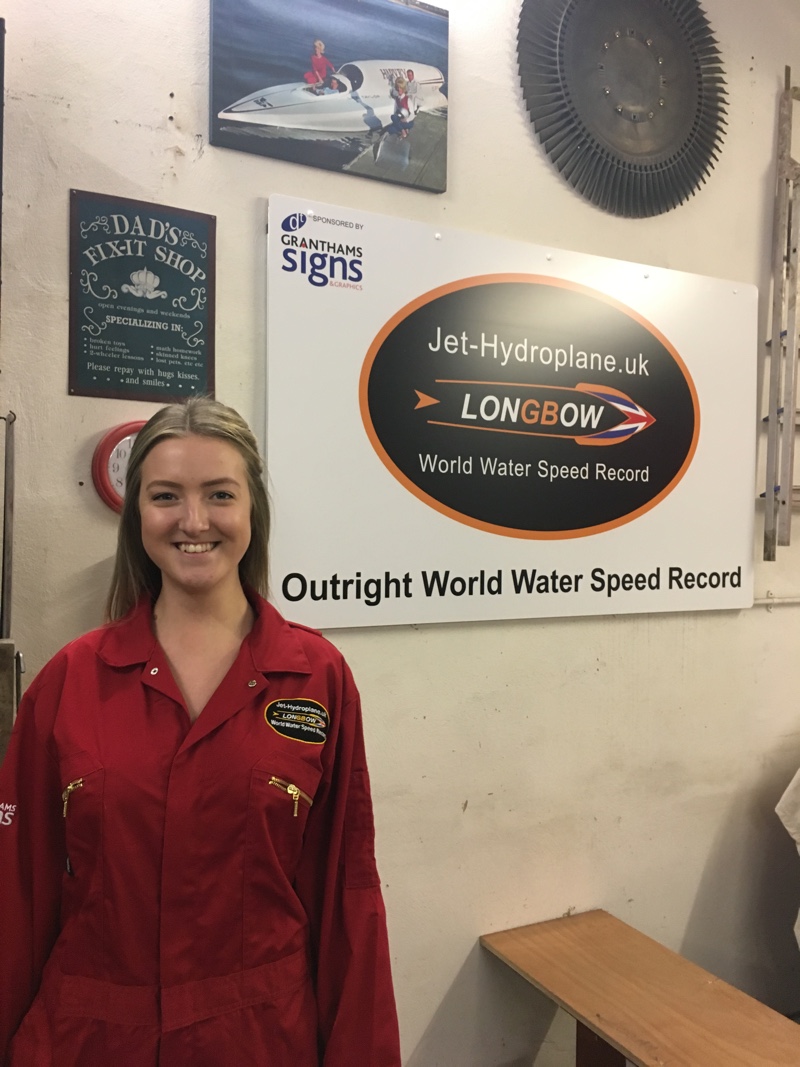
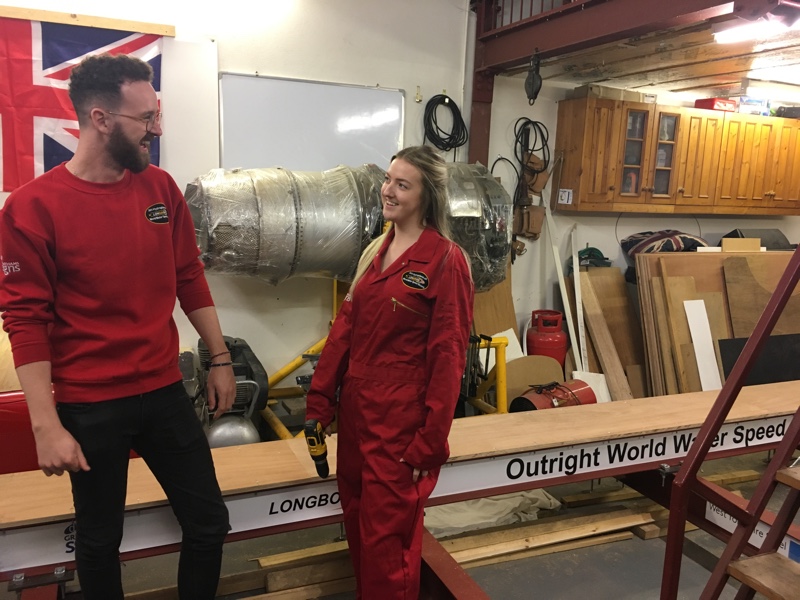
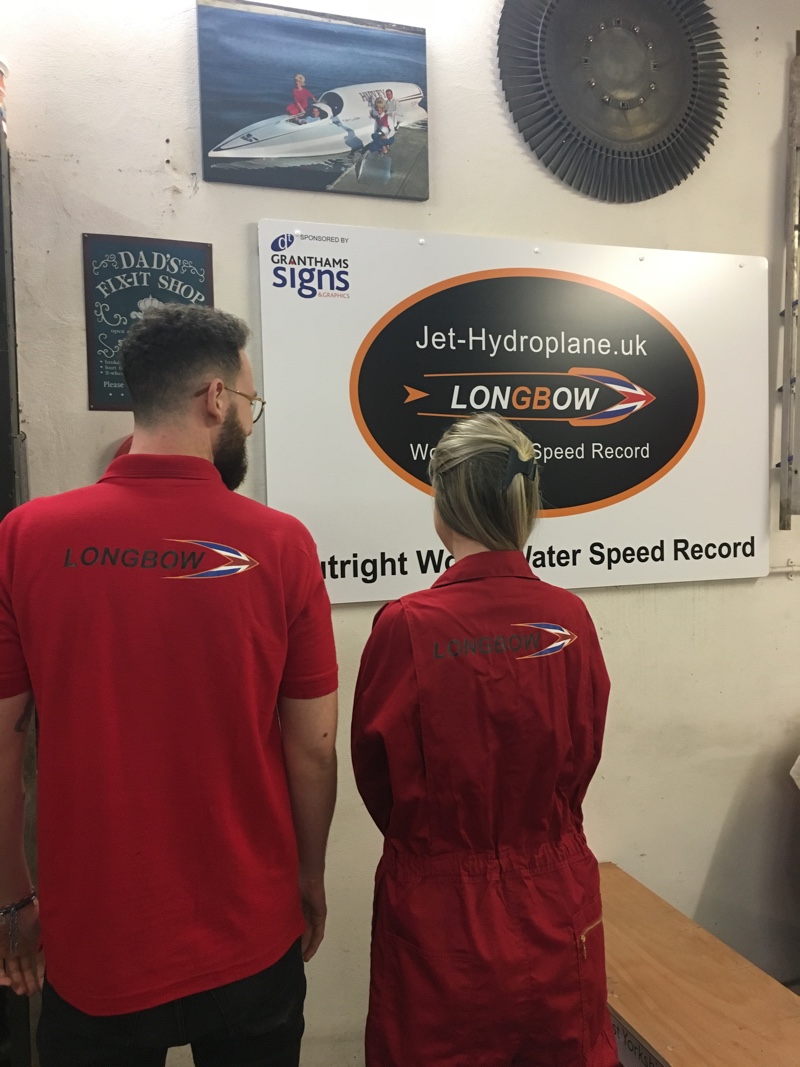
Neil Morton of Progress Concepts helped with the design of the Longbow roundel and decals for this and many thanks to Neil for the continued running and development of the jet hydroplane website. We also have Total fuels on board to supply aircraft grade fuel and oils for testing and running of Longbow when she is completed.
So that is where we are up to at present, we now have the engines to provide the necessary thrust and we have a terrific pool of expertise and sponsors supplying product. It would have been nice to have had a major financial sponsor on board at this stage but even Dave Warby with their pedigree of his family being the current World Record Holders have struggled to source such beyond their good friend John Haggins of AMF. However as Dave and his team begin trialling their new jet hydroplane SOAII powered by their Orpheus gas turbine, (see video clip below with Dave’s kind permission) perhaps people and companies will appreciate the sight and sound of these pure thrust jet hydroplanes running at speed being a truly awe inspiring sight and well worth coming on board with their support.
For us the last year has allowed us to find where we are most comfortable at, with regards to building the craft and that being at our own pace, with a few enthusiasts doing it in their spare time in a home workshop environment, having a good crack to do something rather different and challenging. They do say ‘build it and they will come’, well we don’t know about that but we can certainly give it a go and finally start to get on with it once the wood arrives and hopefully attract a financial sponsor on board as we progress.
As you may appreciate once an engine type and consequential layout is decided upon with construction of the hull commenced, a venture of this type is pretty much committed to that layout. It was therefore important that we took time to set out what our options realistically were to obtain the required thrust to be competitive within a format that has been proven to be workable and hence with least risk to the driver because this record has a history of being unforgiving.
Had we commenced with a hull that would only accept for example an Adour or Orpheus engine only to find it unlikely that we could source such an engine with flight hours remaining, plus spares, within our budget then we would have been left with a dormant hull with no timeframe to mount such a challenge. We therefore apologise for the delay in the previous lack of update upon the website but we were of a mind of only putting something up once we had things such as engines and the right people / companies on board to proceed.
There might in the short term be more pictures of Steve finishing his house refurbishment, than of Longbow being build as his girlfriend waves the rolling pin for him to graft all hours until they take up residence there but he only has one pair of hands and seeing him struggle with that is what makes tuning in all part of the entertainment as we now go forward.
On a more heartfelt note our most sincere best wishes go out to the Belgian Daniel Dehaemers, who having recently completed his reheated Adour jet hydroplane SP600, is now apparently cruelly struggling with health issues just when he should be out trialling the craft and we hope he makes a great recovery to see her on the water as intended. Of note Daniel’s craft is the only jet hydroplane we are aware of that before it has been trialled had a change of engine choice once the hull had been formed from the heavy Avon with considerable rotating mass down to the much smaller and lighter reheated Adour, of which again as far as we are aware Daniel only has one such engine with no spare.
Helical Technology who own the Bluebird replica K777 have gone on to build another replica in the form of the TBR high performance motorcar, derived from the former racing version of the TVR sports car which used to be made local to us in Blackpool. More information on this monster of a car and if you would like to purchase one can be found on: http://helical-racing.com/tbrcars.html
The Bluebird Project led by Bill Smith and Mike Bull continue to make terrific engineering headway in rebuilding Bluebird K7 as she begins to look tantalisingly close to a completed hull once more. We wish them our very best as they move into the latter stages of what has been a mammoth and ground breaking engineering venture over the last 16 years to bring her back to Coniston.
It appears that the Bluebird Project are also assisting David Tremayne run his Viper powered jet car Stay Gold which had a bit of a tumble at Elvington airfield last August but thankfully both car and driver were relatively unscathed and will hopefully return soon, in their bid to crack the British land speed record (301.670mph).
We wish Dave Warby and all of his team the very best as they go forward with further dynamic testing of SOAII upon Blowering Dam in Australia next month and hope the weather is calmer for them this time around.
As we move to the end of the month have a good Halloween / bonfire night, if you have chance you might wish to consider a trip to the Lake District for the 47th Coniston Records Week, 30th October – 3rd November (hoping the weather is good), to see the powerboats hopefully being taken to their limit.
Alternatively at the other end of the Country you may if you hurry consider paying to see Bloodhound run at 200mph during tests at Newquay Airport 26th, 28th and 30th of October. We did ask Andy why they were not going for the British land speed record at the same time as a stepping stone to their 1000mph goal. He said the wheels / tyres they are using were not appropriate for such an attempt and they had their eyes firmly fixed on the bigger prize in South Africa, as and when issues with the rocket engine and financial support are resolved.
To competitors and supporters enjoy the upcoming festivities / events and a reminder to stay as safe as you might through all of that. Please tune back in for what we promise to be a far more regular update and if you managed to read all of the above we hope it did not bore you to much, well done, you deserve a brew and a biscuit.
